If a nuclear disaster is imminent, it’s important for people to take quick action to ensure the safety of everyone in their family. Although it’s better to plan weeks or months in advance, there are some protective actions that can be taken during a national crisis to prevent death or long-term illness. Experts say it’s best to print out guidelines for surviving a nuclear attack since it may be impossible to access the Internet or receive information via the radio, cellular phones or television.
Deciding whether to evacuate
The first step that must be taken is to decide whether to stay or go. Experts say it is extremely dangerous to be stuck on a highway or out in the open during a nuclear strike because of the radiological and chemical agents in the air. It’s important to avoid inhaling radioactive dust. Experts say it’s not worth the risk to attempt evacuation if it’s not clear whether traffic has been restricted and whether fuel will be accessible. If notified several days or weeks ahead of a strike, evacuate with ample emergency supplies and fuel.
Understanding what’s happening
 People who don’t have a home with a built-in bomb shelter or basement can improvise an emergency fallout shelter. The key is to understand the principles of radiation protection. The goal is for people to protect themselves and their family and pets from radioactive fallout or the dust produced from a nuclear explosion. It’s obviously more dangerous to be closer to ground zero. It’s critical that every family member understands that they may not be able to actually see the fallout dust even though it’s extremely toxic. The fallout dust can emit radiation energy that is deadly. Overtime, the fallout loses its intensity.
People who don’t have a home with a built-in bomb shelter or basement can improvise an emergency fallout shelter. The key is to understand the principles of radiation protection. The goal is for people to protect themselves and their family and pets from radioactive fallout or the dust produced from a nuclear explosion. It’s obviously more dangerous to be closer to ground zero. It’s critical that every family member understands that they may not be able to actually see the fallout dust even though it’s extremely toxic. The fallout dust can emit radiation energy that is deadly. Overtime, the fallout loses its intensity.
Delegating tasks to family members
Because time is of the essence if a nuclear strike is imminent, it’s important to assign tasks to different people. Consider having emergency drills before the disaster becomes imminent. Divide the tasks into the top priorities such as food, water, shelter and medicine. Have someone seal the windows and openings inside the house or basement so fallout does not blow in.
Gathering the food and water
Although it doesn’t hurt to have cash or gold on hand, having money isn’t as much of a priority as having clean food and water to survive the initial nuclear fallout. Clean water is of the essence. In an emergency, fill all available containers in the home with tap water before the nuclear strike. Fill up the washer and bath tubs. Put a liner in large garbage bags and fill them all up with water. Gather together food in sealed containers. Include in the food storage protein shakes that include potassium iodine or algae. Have someone use duct tape to seal windows and doors from the outside.
Preparing the shelter
The reason it’s critical to prepare a fallout shelter is because radiation is deadly. People can shield themselves from radiation by putting as much mass as possible between their bodies and the radiation outdoors. A rule to follow is to place 16 inches of brick or hollow concrete blocks filled with sand, 2 feet of packed earth or 5 inches of steel as a barrier shield from radiation. Sine most people don’t have time to construct a steel fortress, it’s best to use books, furniture or anything available to reduce radiation intensity or absorb the radiation.
Making the experience bearable
To make the situation less stressful, have plenty of baby wipes handy for bathing. Purchase portable radios in order to hear any emergency updates. Experts recommend taking Potassium Iodine or KI tablets to guard against cancer caused by radiation. If no tablets are available, rub iodine on the skin. Some of the other items to have handy include fire extinguishers, tools and duct tape. Keep LED flashlights handy as well as pillow and blankets.
Experts with FEMA say there are three main factors people need to understand when trying to protect themselves from a nuclear blast: time, shielding and distance. They say the greatest threat to radioactive fallout is within the first two weeks. When trying to locate the best fallout shelter, choose one that provides the best shield between the people and the fallout particles such as thick walls and bricks. Also, if a person has time to evacuate as far away from the planned target as possible, it’s ideal. It’s very possible to survive a nuclear attack by being educated and prudent. Stay calm and patient while until the threat has cleared.
For more info on disaster preparedness visit http://www.ready.gov/

